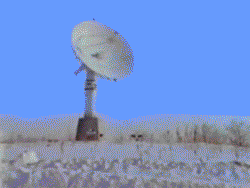Proactive disclosure
Print version   |  | 
Natural Resources Canada > Earth Sciences Sector > Priorities > Canada Centre for Remote Sensing
Tracking the satellites CCRS antennas
At each of the CCRS receiving stations there are two antennas, each with a 10 metre diameter reflector. The large diameter allows for better reception of even weak signals.

Concrete Base: elevates and stabilizes the antenna and contains prime power panels and heat.
Base Extension: further elevates the antenna and houses the power amplifiers.
Tilt Mechanism: permits 2.5 degrees of tilt to enable antenna to track near-zenith passes.
Elevation over Azimuth Pedestal: principal mechanism for pointing the antenna in elevation (vertical angles) and azimuth (horizontal angles).
Counterweights: balances the weight of the 10m reflector and feeds.
Downconverters: convert the data stream from the incoming X and S-bands (8GHz and 2GHz), to 375 MHz.
Reflector: 10m diameter, paraboloid made up of 24 solid-surface reflector panels made of spun aluminum; the reflector surface is heated to prevent the accumulation of ice and snow.
Sub-Reflector: a dichroic, meaning that it's partly reflective (for X-band frequencies that are reflected onto the X-band feed) and partly transmissive (for S-band frequencies); it is positioned at the focal point of the paraboloid.
X-band Feed: receives the focused X-band signal and contains Low Noise Amplifiers and filters to remove unwanted frequencies.
X-band Feed Extension: positions the X-band feed to receive the X-band portion of the signal as it is reflected from the dichroic sub-reflector.
Aircraft Warning Lights: to warn approaching aircraft of the presence of the antenna.
Lightning Rod: to re-direct lightning strikes away from sensitive equipment.

|
